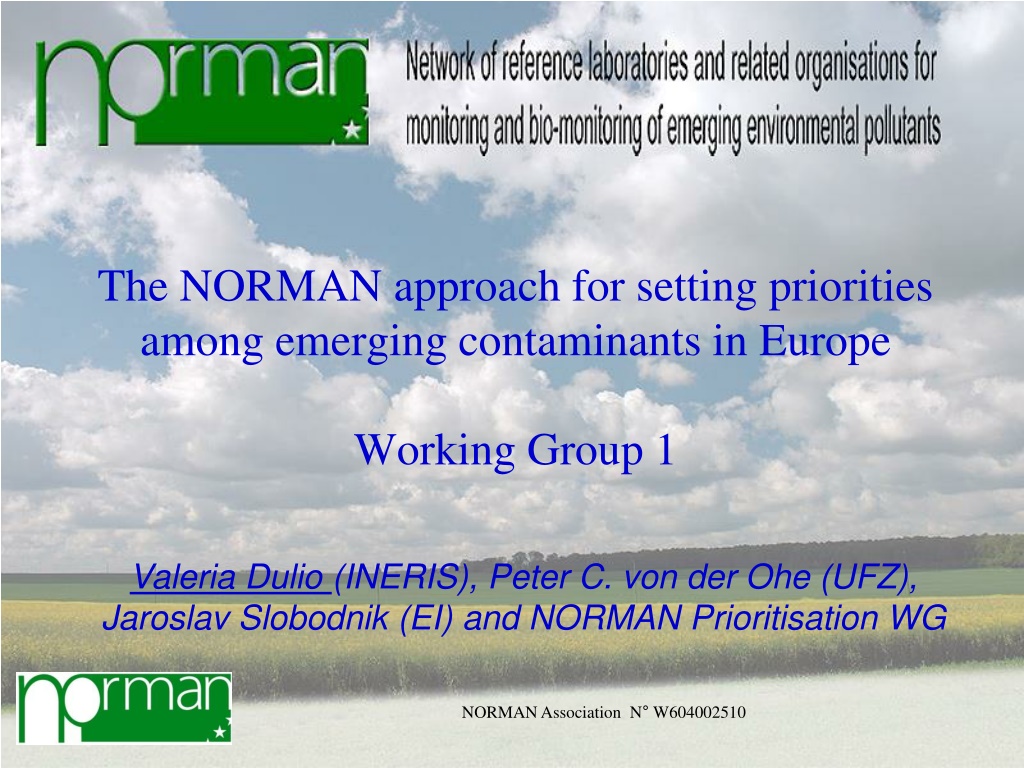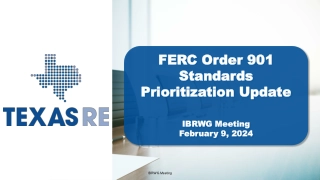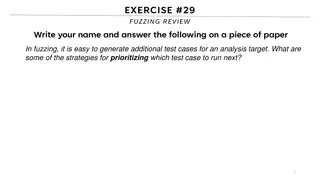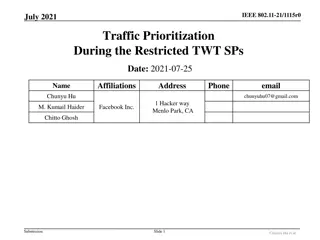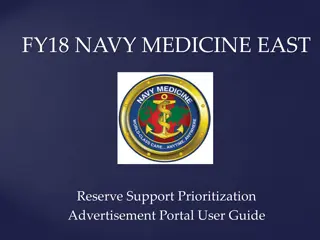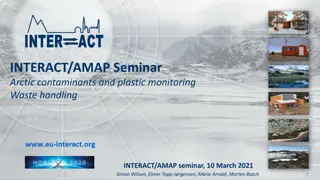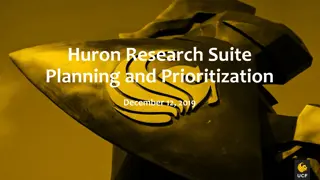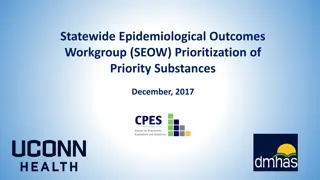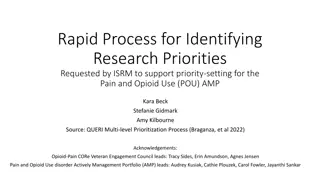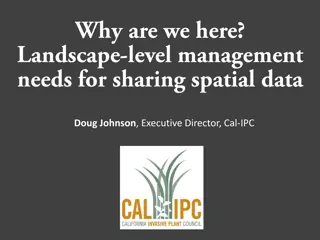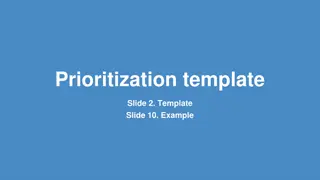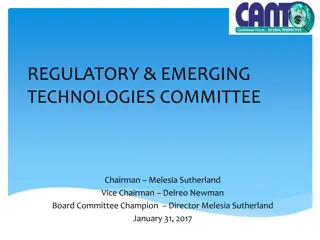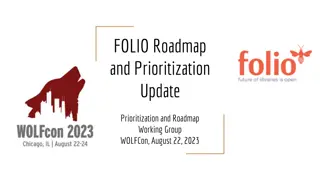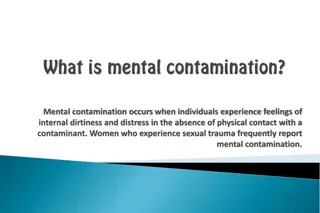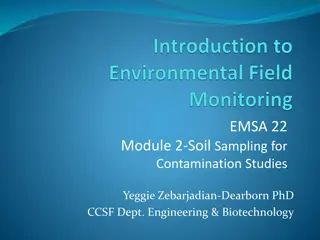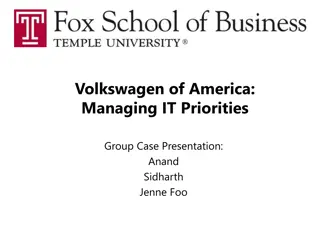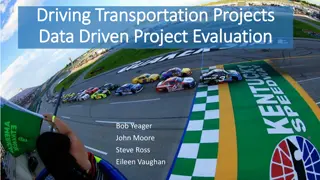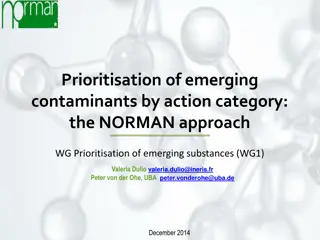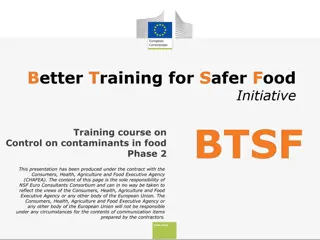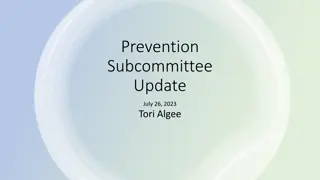Prioritization of Emerging Contaminants in Europe
The NORMAN approach focuses on setting priorities among emerging contaminants in Europe by selecting over 700 substances based on expert judgment and scientific literature citations. The prioritization scheme specifically designed for emerging substances involves assessing knowledge gaps and necessary actions for exposure, hazard, and risk assessments, allocating substances to action categories, and categorizing actions needed. Six action categories are identified, each with specific criteria and recommendations for managing emerging contaminants effectively.
Download Presentation

Please find below an Image/Link to download the presentation.
The content on the website is provided AS IS for your information and personal use only. It may not be sold, licensed, or shared on other websites without obtaining consent from the author.If you encounter any issues during the download, it is possible that the publisher has removed the file from their server.
You are allowed to download the files provided on this website for personal or commercial use, subject to the condition that they are used lawfully. All files are the property of their respective owners.
The content on the website is provided AS IS for your information and personal use only. It may not be sold, licensed, or shared on other websites without obtaining consent from the author.
E N D
Presentation Transcript
The NORMAN approach for setting priorities among emerging contaminants in Europe Working Group 1 Valeria Dulio (INERIS), Peter C. von der Ohe (UFZ), Jaroslav Slobodnik (EI) and NORMAN Prioritisation WG NORMAN Association N W604002510
NORMAN list of emerging substances (update 2011) More than 700 substances Selected by the NORMAN experts, based on citations in the scientific literature and expert judgment Algal toxins Anticorrosives Antifoaming agents Antifouling compounds Antioxidants Biocides Complexing agents Detergents Disinfection by-products Flame retardants Fragrances Gasoline additives Industrial solvents Engineered Nanoparticles Perfluoroalkylated substances Personal care products Pesticides Pharmaceuticals Wood preservatives Need to set priorities !
Prioritisation of emerging substances Emerging substances often overlooked with conventional prioritisation methodologies NORMANprioritisation scheme Designed specifically for emerging substances : Knowledge gaps Actions needed
List of emerging substances - Data collection & Validation Exposure assessment Hazard assessment Criteria Risk assessment Allocation of substances to action categories 1 2 3 4 5 6 A specific set of indicators for each category Ranking of substances within each category 1 2 3 4 5 6 Priority Substances in each action category Review process NORMAN Association N W604002510
CATEGORISATION: what are the actions needed?
Six action categories 1. Sufficient exposure/hazard info - risk: Candidate PS/RBSP 2. Lack of exposure info: Screening campaigns 3. Lack of ecotox info: Hazard assessment (PNEC) 4. LOQ > PNEC/EQS: Improvement of analytical methods 5. Lack of exposure AND ecotox info: Screening AND hazard assessment 6. Sufficient exposure/hazard info no risk: Reduce monitoring efforts NORMAN Association N W604002510
Classification into Action categories (NORMAN list) Univers of substances >4 countries AND /OR > 100 sites with analysis >20 sites analysis > LOQ in the relevant matrix(ces) + Recent data (>last 6 years) Insuff. (or never) investigated OR measured in the wrong matrix Suff. investigated but low frequency of quantification Suff. investigated and quantified in the relevant matrix Availability of experimental data for EQS derivation? yes LOQ < PNEC (existing data in the database)? no no yes MEC95 > PNEC ? LOQs expert labs < PNEC ? All data <LOQ yes no no yes Availability of experimental data for EQS derivation ? yes no Cat. 6: non priority for regular monitoring Cat. 3: Action (eco)tox Cat. 4: Action Analytical Cat. 1: Candidates ecological status Novel end points Cat. 2: Screening study Cat. 5
MEC 95 and Lowest PNEC Risk ratio MEC 95 / Lowest PNEC (to identify potential risk) MEC 95 Take the maximum concentration at each site (MECmax_site) Calculate 95th percentile of all MECmax_site values (MEC95) Lowest PNEC Predict missing acute toxicity data with read-across models (see kNN read-across methodology Sch rmann et al. 2011, EST, DOI:10.1021/es200361rf) Use Lowest value of PNEC acute (lowest LC50 / 1000) and PNEC chronic (Lowest NOEC / 100), instead of preferring chronic over acute data per se
Lowest PNEC Lowest value of available PNEC acute and PNEC chronic for hazard assessment, instead of preferring chronic over acute data per se Ecotoxicological database STD Sufficient acute data ? Sufficient chronic data ? Yes No Yes PNEC acute PNEC chronic P-PNEC STD = standard test data Lowest PNEC
Prioritisation indicators Exposure indicators: N of countries/sites with analyses, frequency of quantif. Use pattern (applied in the environment, diffuse sources, point sources) PBT, vPvB properties Hazard indicators (effects on ecosystems and human health) : Novel end points (behavioural effects) CMR properties (4 classes according to EU classification) Endocrine disruption potential Risk indicators: Frequency of exceedence of the PNEC (spatial exposure) Extent of exceedance of the PNEC (intensity of impact)
Collected data Kow (partit. coeff. octanol/ water) 692 / 707 subst. (INERIS) ~ 1100 tests Koc (adsorption coeff.) 691/ 707 subst. (INERIS) ~550 tests S (hydrosolubility) 693 / 707 subst. (INERIS) Fugacity models 559 / 707 subst. (UFZ) PNEC (P-PNEC)water/ sed / biota (experim. data + calculated values *) 707 / 707 subst. (UFZ, INERIS) ~ 700 tests Monitoring data (EMPODAT database) 1 037 000 data for 359 substances (NORMAN members) LOQ (analytical performance) Available in the NORMAN DB + litterature search and expert labs for > 400 substances (INERIS, NORMAN members) Classification PBT, vPvB, CMR, ED 693 /707 *kNN read-across methodology, Sch rmann et al. 2011, EST DOI:10.1021/es200361r)
NORMAN scheme applied for assessment of 500 substances within FP6 Modelkey project Monitoring data provided by: Joint Danube Survey (JDS2) and four regional water authorities (Elbe, Scheldt and Llobregat river basins) von der Ohe et al. 2011, STOTEN, doi.org/10.1016/j.scitotenv.2011.01.054
NORMAN scheme applied in France Water monitoring campaign 2012 (INERIS, ONEMA) Improve info about less investigated substances Prepare future revision of RB specific pollutants list (WFD) 2316 candidates subst. (700 already part of national monitoring) TOP PRIORITY subst. : 221 water and 370 in sediment Screening study (CAT.2) Improvement of analytical performance (CAT.4)
20 top priority subst. (FR) with LOQ > PNEC Substance name LOQwater g/L Score Use category Flufenoxuron 17 alpha-Ethinyloestradiol 3,3'-Dichlorobenzidine Triphenyltin ion Beta-sitosterol Bromofos-methyl closantel Hexabromocyclododecane (HBCDD) Fenitrothion Cyfluthrin Thiram Bioresmethrine Flumioxazine Di-n-octylphthalate (DOP) Tetrabutyltin ion Chloroprene Benzidine Oxadiargyl Metrifonate (Trichlorfon) Mevinphos Diazinon Dichlorvos 0,0001 0,0001 32,5 pesticides 32 pharmaceuticals 31 Industrial chemicals 31 Antifouling compounds 30 pharmaceuticals 30 pesticides 30 pharmaceuticals 30 Flame retardants 28,5 pesticides 28,5 pesticides 28,5 pesticides 27,5 biocides 27,5 pesticides 27 Plasticisers 27 Antifouling compounds 26 Industrial chemicals 25 Industrial chemicals 25 pesticides 23,5 pesticides 23,5 pesticides 22 pesticides 20 pesticides 1 0,001 0,0001 0,008 0,015 0,01 0,005 0,00088 0,0001 0,001 0,001 0,05 0,01 2 0,001 0,001 0,001 0,001 0,005 0,005
NORMAN prioritisation approach applied successfully at the national and international river basin level; Coming soon: results of the prioritisation exercise applied to NORMAN List of emerging substances; Further data sharing at EU level to identify reliably new EU priority substances: all data on emerging substances generated in Europe should end up in one database; Interested to share your data to improve prioritisation of emerging substances ? Contact Valeria Dulio at www.norman-network.net
NORMAN WG on Prioritisation of Emerging Substances: Valeria Dulio, Sandrine Andres, INERIS Peter von der Ohe, Werner Brack, UFZ - Leipzig Jaroslav Slobodnik, Environmental Institute Heinz Ruedel, Fraunhofer Institute Willie Peijnenburg, RIVM Juliane Hollender, EAWAG Patrick Roose, OSPAR Martin Keller, BfG Eva Brostrom-Lunden, IVL Anja Derksen, AD Eco advice H l ne Budzinski, Patrick Mazellier, University of Bordeaux Laurence Amalric, BRGM David Schwesig, IWW Vera Ocenaskova, TGM James Franklin, PlasticsEurope Armelle Hebert, VEOLIA Environment
